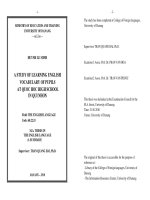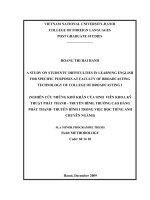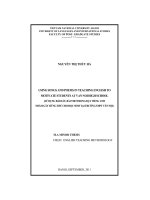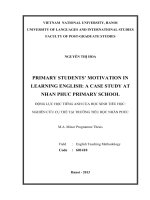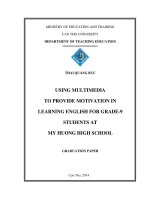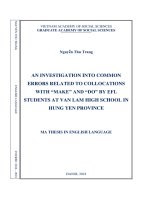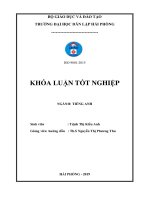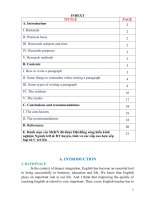using multimedia to provide motivation in learning english for grade9 students at my huong high school
Bạn đang xem bản rút gọn của tài liệu. Xem và tải ngay bản đầy đủ của tài liệu tại đây (694.26 KB, 45 trang )
MINISTRY OF EDUCATION AND TRAINING
CAN THO UNIVERSITY
DEPARTMENT OF TEACHING EDUCATION
THAI QUANG BUU
USING MULTIMEDIA
TO PROVIDE MOTIVATION IN
LEARNING ENGLISH FOR GRADE-9
STUDENTS AT
MY HUONG HIGH SCHOOL
GRADUATION PAPER
Can Tho, 2014
MINISTRY OF EDUCATION AND TRAINING
CAN THO UNIVERSITY
DEPARTMENT OF TEACHING EDUCATION
THAI QUANG BUU
USING MULTIMEDIA
TO PROVIDE MOTIVATION IN
LEARNING ENGLISH FOR GRADE-9
STUDENTS AT
MY HUONG HIGH SCHOOL
GRADUATION PAPER
Major: English Language Teaching Education
Supervisor: NGO THI TRANG THAO, M.A
Can Tho, 2014
iii
DECLARATION
The graduation paper entitled “Using multimedia to provide motivation in learning
English for grade-9 Students at My Huong High School” is conducted under the
supervision of NGO THI TRANG THAO (M.Ed.), at English Language Education
Department, School of Education, Can Tho University.
I hereby declare that the current thesis report is the result of my own work, except where
due reference or citation is made.
Can Tho, May, 2014
Researcher
Thái Quang Bửu
TABLE OF CONTENTS
DECLARATION iii
LIST OF TABLES vi
LIST OF FIGURES vii
ACKNOWLEDGEMENT 8
ABSTRACT 9
ABSTRACT (VIETNAMESE VERSION) 10
CHAPTER 1: INTRODUCTION 11
1.1. Rationale 11
1.2. Research aims 12
CHAPTER 2: LITERATURE REVIEW 14
2.1 Multimedia 14
2.3 Applications of multimedia and types of multimedia: 19
2.4 Summary 23
CHAPTER 3: RESEARCH METHODOLOGY 24
3.1 Research questions 24
3.2 Research hypothesis 24
3.3 Research design 24
3.4 Participants 24
3.5 Research instrument 25
3.6 Data gathering procedure 25
CHAPTER 4: RESULT AND DISCUSSION 27
4.1 Results of the study 27
v
4.2 Discussion on the connection between frequency and motivation 30
CHAPTER 5: CONCLUSIONS AND RECOMMENDATIONS 33
5.1. Summary of the study 33
5.2 Recommendations for English high school teachers and English learners 33
5.3 Limitation and suggestion for further researches 34
5.4 Conclusion 35
REFERENCE 36
APPENDIX 38
LIST OF TABLES
Table
Title
page
Table 1:
Descriptive statistics of mean scores of frequency of multimedia
methods used by teacher and grade-9 students at My Huong
High School
25
Table 2:
Descriptive statistic of mean scores of motivation provided by
using the seven-types of multimedia methods
26 - 27
vii
LIST OF FIGURES
Figure
Title
page
Figure 1:
Detailed mean scores of motivation provided by using the seven-
types of multimedia methods
29
8
ACKNOWLEDGEMENT
I would like, first of all, to express my deep gratitude to my supervisor, Mrs. Ngo Thi
Trang Thao for her enthusiastic guidance from the beginning to completion of this paper.
Without her valuable advice and critical comments, this research could not have taken
its shape. To what more, her consultancy and encouragement were an endless source of
support and an indispensable factor in the success story of this research.
Besides, I wish to take a chance to thank the principle of My Huong High School, Mr.
Thai Minh Dien, who accepted my request and allow me to do my research in his school.
Furthermore, I sincerely appreciate the cooperation of 102 high school students in grade
9 from My Huong High School in finishing the questionnaires, particularly for their
enthusiastic and serious participants.
Finally, I am grateful to my parents, my friends, teachers, classmates and my sister, Ms.
Thao, who have always been beside with me to encourage me and assist me during my
study.
9
ABSTRACT
In recent years, multimedia has gradually become the mean of teaching in most schools
all over the country. The reason for this trend is that educational multimedia can provide
students motivation in learning English. To take advantages of this opportunity, a
research is planned to proceed with two aims: (1) to find out which multimedia methods
teachers and students often use; (2), to understand what multimedia methods motivate
students in learning English. Based on the two aims and their hypothesis, two research
questions are built up to aid the questionnaire. Many researches have pointed out that if
students are motivated enough, that means if teachers or students themselves use
multimedia as a tool to enhance learners’ motivation, it will make a great impact to the
entire learning process, which will lead to both effective teaching and effective learning.
Thus, this research is conducted to investigate the effect of using multimedia as
motivation of seventy-five grade-9 students at My Huong High School. From the data
collected from the questionnaire, the problems are uncovered relating to basic steps of
doing research.
TÓM LƯỢT
Trong những năm gần đây, đa truyền thông đang dần dần trở thành phương tiện giảng
dạy ở đa số các trường học trong khắp cả nước. Xu hướng này hoàn toàn hợp lí vì đa
truyền thông làm cho công tác giảng dạy học sinh cũng như tạo động lực học cho các
em trở nên đơn giản và hiệu quả hơn. Nhân thời cơ trên, nghiên cứu này được lên kế
hoạch để tiến hành với hai mục đích chính. Thứ nhất, khám phá phương tiện đa truyền
thông nào được sử dụng thường xuyên trong công tác giảng dạy. Thứ hai, hiểu được
phương tiện đa truyền thông nào cung cấp động lực học cho các em học sinh một cách
đầy đặn. Dựa vào mục đích trên, hai câu hỏi nghiên cứu được đưa ra để tiện hơn trong
việc lập ra bảng câu hỏi phục vụ cho công tác nghiên cứu. Nhiều nghiên cứu đã chỉ ra
rằng nếu các em học sinh được cung cấp đầy đủ động lực học, đồng nghĩa với việc giáo
viên sử dụng các phương tiện đa truyền thông thích hợp, thì các em sẽ học tiếng Anh
hiệu quả hơn. Cho nên, nghiên cứu này được lập ra để điều tra 75 em học sinh lớp 9 ở
trường Trung học cấp 2-3 Mỹ Hương, những vấn đề ban đầu được đặt ra dần dần được
khám phá đầy đủ với qui trình thích hợp.
11
CHAPTER 1
INTRODUCTION
This chapter will address the following five sections: (1) the rational of the research, (2)
the research aims, (3) the significance of the research, and (4) the thesis organization.
1.1. Rationale
In the early preproduction stage of second language acquisition, students start to
communicate with each other by using simple sentences and teachers play the role of
scaffolding. According to Sawyer (2006), scaffolding is the support given during the
learning process which is tailored to the needs of the student with the intention of helping
the student achieve his/ her learning goals. However, many difficulties are met because
students are not able to understand what their teachers are talking about. The reason of
this issue is understandable because English is the subject that students have no control
on; students may comprehend the other subjects because they are taught using their
mother tongue. English, on the other hand, has to be taught using the different teaching
methods due to the significant nature of the subject.
According to Tran (2013), students in the age from 15 to 18 in general and grade-9
students in particular are in the pre-adult stage. In school, learning activities are still the
main activity; however, it requires positive and independent of students. To deeply
comprehend the course, students must have a level of conceptual thinking high enough,
that means students must be taught English using new methods, not just old and
traditional teaching styles. English with students in this stage is new and discoverable;
if students are provided enough motivation, students will find the subject interesting and
the next stages of second language acquisition would be simpler.
Researchers have studied for the aspiration of finding new methods that help teaching
become more effective and successful. Although the term “multimedia” is familiar for
teachers at that time, Malik & Agarwal (2012) state that multimedia facilitates mastering
basic skills of students by applying drill and practice. Nevertheless, the aim of
encouraging students to learn English throughout multimedia is still not considered
carefully by teachers due to the lack of researches on the field of high-school context in
general and in Vietnamese high-school settings in particular.
In attempt to get deeper understanding of the issue, this study aims to explore the use of
multimedia in motivating students in learning English.
1.2. Research aims
The research aims are to examine teachers’ and students’ using of multimedia as a
possible resource for practicing and developing motivation in more effective English
learning. Specifically, they are:
(1). to find out which multimedia methods teachers and students often use
(2). to understand what multimedia methods motivate students in learning English
1.3 Research significance
The findings of this research will be helpful to both high-school teachers and learners.
Through learners’ beliefs, teachers can know what multimedia method that learners want
and expect them to use and what multimedia method is effective in learning process of
learners. Being aware of these beliefs will allow teacher to choose appropriate ways to
reach students’ needs. This will also result in getting learners to gain more success in
their English learning process. In addition, students may be instructed to have proper
attitudes toward the multimedia methods.
1.4 Research organization
The research consists of five chapters:
Chapter 1, Introduction, presents the rationale to conduct the study, the aims of the
research, the research significance and organization of the research.
Chapter 2, Literature review, provides the theoretical framework for the study
including the definition of multimedia, educational multimedia, and its advantages.
13
Besides, the definition of motivation will be discussed. Then, the applications of
multimedia in providing motivation for students and types of multimedia methods will
also be mentioned in this part.
Chapter 3, Research methodology, describes the methodology used in the research
involving research design, participants, instruments and the procedures for data
collection and analysis.
Chapter 4, Result and Discussion, reports and represents the findings of the research
Chapter 5, Implications, Limitations, Recommendations and Conclusion,
summarizes what is addressed in the study. Next, limitations and some pedagogical
implications from this research will be discussed. Finally, directions for further research
will be provided.
CHAPTER 2
LITERATURE REVIEW
2.1 Multimedia
2.1.1 Definition of multimedia
Humans receive data through multiple channels, i.e., media, including audio and visual
channels (Paivio, 1969) as well as touch, taste and smell. Multimedia is most commonly
defined as the use of at least two of these elements: sound (audio), and text, still graphics,
and motion graphics (visual) (Tannenbaum, 1998). The importance of multiple channels
for delivery of educational content can be found in the theory of multi-channel
communication which confirms that when information is presented by more than one
channel, there will be additional reinforcement, resulting in greater retention and
improved learning which is also known as multimedia (Bagui, 1998; Daniels, 1994; Ellis,
2004).
Schwartz & Beichner (1999) argue that multimedia is in essence a presentation of
information that incorporates multiple media such as text, audio, graphics, and animation.
Multimedia need not be computerized, but computers offer some of the most seamless
multimedia presentations.
2.1.2 Multimedia in education
2.1.2.1 What is educational multimedia?
As it has been clearly defined earlier, multimedia is a judicious mix of various mass
media elements such as text, audio, images, animation or video. However, in educational
circumstances, Neo M. and Neo T.K. (2009) argue that multimedia provides a
technology based constructivist learning environment where students are able to solve a
problem by means of self-explorations, collaboration and active participation.
Simulations, models and media rich study materials like still and animated graphics,
video and audio integrated in a structured manner facilitate the learning of new
15
knowledge much more effectively. The interactive nature of multimedia provides the
room to enhance traditional "chalk-and-talk" method of teaching with more flexibility to
learners to adapt to individual learning strategy (Neo, 2007). It enables both the
educators and learners to work together in an informal setting. The role of educators and
learners are extended. Furthermore, it encourages and enhances peer learning as well as
individual creativity and innovation.
2.1.2.2 The advantages of using multimedia inside and outside L2 classroom
The promise of revolutionizing education through the use of multimedia can be found as
early as 1922 when Thomas Edison proclaimed that “the motion picture is destined to
revolutionize our educational system and that in a few years it will supplant…the use of
textbooks” (Mayer, 2005). Other proclamations include Benjamin Darrow who
proclaimed that radio would “bring the world to the classroom”. His colleague, William
Levenson predicted in 1945 that a “radio receiver will be as common in the classroom
as the blackboard” and “radio instruction will be integrated into school life” (Mayer,
2005). Considering also the history of educational television combining visual and audio;
by the 1950s educational television was touted as a way to create a “continental
classroom” that would provide access to “richer education at less cost” (Mayer, 2005).
Ninety years later, in Malik & Agarwal’s study (2012), they state that multimedia
facilitates mastering basic skills of a students by applying drill and practice. It helps in
problem solving by doing and understanding abstract concepts, providing enhanced
access for teachers and students in remote locations, facilitating individualized and
cooperative learning, helping the managements and administrations of classroom’s
activities and learning content, and simulating real life problem handling environments.
For instance, text alone simply does not allow students to get a feel of any of
Shakespeare's plays. In teaching biology, an instructor cannot make a killer whale come
alive in a classroom. Multimedia enables us to provide a way by which learners can
experience their subject in a creative way. The appeal of multimedia learning is best
illustrated by the popularity of the applications currently available in the internet
applications market. These are multimedia programs combining text, audio, video, and
animated graphics in an easy-to-use way.
Multimedia has permeated every part of our society. No tools or teaching methods have
had greater impact than multimedia. As a teacher, we have an opportunity to engage our
students like never before through interactive games, video, presentations and so on. We
now can meet our students’ needs in a more interactive and entertainment way.
Integration of multimedia into instruction can help to reduce curriculum barriers and
improve learning for all students. This following part provides a basic introduction to
multimedia and describes how it can be used to support student learning.
Improves Learning: Numerous studies over the years have shown that interactive
multimedia learning takes less time, is enjoyed more and increases learning (Hick, 1997.)
Interactive: Interactivity is mutual action between the learner, the learning system, and
the learning material. Numerous studies have found that interactivity has a strong
positive effect on learning (Hick, 1997.)
Practical: It is capable of presenting true-to-life situations that learners face every day.
Students can be trained to be a practical learners - they learn best when faced with real
problems that have real consequences. Decision tree simulation, video simulations or
simple animations allow students to learn-by-viewing, learn-by-doing or learn-by-
coaching (Hick, 1997.) All are effective methods for developing motivation and
increasing information retention.
Engaging: Interactive learning with live-action video, audio, graphics, feedback, expert
advice, and questions and answers keep learners interested and reinforces skills. Because
it is exciting, challenging, and fun to use, it encourages learners to return to the program
again and again. Through continual practice, learning is absorbed and integrated into
daily performance (Hick, 1997.)
17
Multimedia becomes more accessible to teachers and students; its potential to become a
tool to enhance learning result become a practical option when technology is spreading
like a wildfire all around the world.
2.1.2.3 Contributions of multimedia to education:
The role of technology and multimedia in language learning in general cannot be denied.
Practicing with audiotape in classroom or computer lab in high school and the university
help build a foundation for learner’s ability to familiar with syntax and vocabulary of the
target language. On the other hand, computer is perceived as a tool of enhancement to
help students in learning a second language. The large amount of using computer in the
target language instructions in the past decade attests this belief (Meskill, 1996.) Both
audiotape and computer provide individualized positive outcomes to the target language
which students can actively use and control in self-study. On top of that, using
multimedia in learning skills of the target language in general has more expectation since
the growth of technology these days is fast and powerful, students can now interact with
the target language which can help raising the interest in daily lessons, students are not
forced to read or listen to such long and boring topics in the textbook when teachers hold
the capability to find more interesting ones on the internet.
However, arranging the combination of several kinds of multimedia into intelligent and
pedagogically-driven lessons is a real challenge to material developers (Meskill, 1996.)
It is important to understand that we must first engage the attention of our students before
they are ready to learn. Multimedia helps teachers organize a more effective lesson by
providing different instructions and learning styles (Meskill, 1996.) Having different
ways to present information to the students allows teachers meet the needs of all students
in L2 classroom, multimedia also provides plenty of different tools that can support
teachers in designing lessons which are easier to understand, students are now not just
listening to the lesson but they can see, hear, imagine what things feel like as multimedia
is used to bring objects to life. The more creative and dynamic a teacher is, the better
his/her students are.
Multimedia enables us to provide a way by which learners can experience tasks in a
whole new manner. The key to provide this experience is having simultaneous graphic,
text, video and audio rather than in a sequential manner. For example, in learning
listening skills, students are now able to find interaction with the tasks instead of just
sitting steady and listening to a conversation that is broadcasted through a tape.
The pedagogical strength of multimedia is that it uses the natural information processing
abilities that we already possess as human. Our eyes and ears, in conjunction with our
brain, form a formidable system for transforming meaningless sense data into
information (Meskill, 1996.) The old saying that “a picture is worth a thousand words”
often understates the case especially with regard to moving images, as our eyes are
highly adapted by evolution to detect and interpret moving objects. Including images or
videos into listening tasks can help approaching students in many ways that we cannot
possibly imagine. The mind of a high school student is still young and it seeks for
satisfaction not boring-wall-of-text. For example, when teaching vocabulary, a video of
a song playing on a colorful background would be more valuable to the students, in this
respect, using text only, even in a creative way, has obvious limitations as compared to
the use of both text and moving images.
2.2 Using multimedia as motivation
Abrahamson (1998) may represent the majority of multimedia advocates when he states
that “a primary function of the use of television, computers, and telecommunications in
distance learning is to motivate students rather than just to provide information to them”.
However, evidence for the motivational qualities of multimedia instruction has been
elusive at best. The best conclusion at this point is that overall, multimedia courses may
be more attractive to students and so they tend to choose them when offered options.
What is motivation in particular?
Pintrich & Schunk (2002) in their review of research on motivation to learn suggest that
the existing research focuses on one or more of three “indexes” or outcomes of
19
motivation: 1) active choice, actively starting to do something that one formerly
“intended” to do but had not started, 2) persistence, continuing to work towards a goal,
despite distractions or competing goals, and 3) mental effort, “the number of non-
automatic elaborations invested in learning” (Salomon, 1984.)
Each of these indices plays a different role in the learning process and some may not be
related to learning. On one hand it is possible that active choice (e.g. the choice to engage
in multimedia learning by choosing to start a multimedia lesson or to select a multimedia
course alternative over a more traditional option) may be facilitated by attractive
multimedia features such as ease of access, flexibility of scheduling and the personal
control students are often able to exercise when starting, pausing or moving between
different sections of a multimedia materials.
There is a persistent belief among some segments of the education and training
communities that the most effective learning experiences are those in which learners
navigate unstructured multimedia learning environments or solve novel problems
presented without instructional supports (Land & Hannafin, 1996.) It is believed that the
roof of motivation is self-study environment where students can discover knowledge
without any higher level supports and the best way to motivate students is to let students
motivate themselves. Multimedia is the tool teachers need to aid this belief. According
to Clark (2001), multimedia offers extraordinary benefits to education including a wide
range of instructional options and, with sufficient instructional design, considerable
reductions in the time required to learn without the supports of teachers.
2.3 Applications of multimedia and types of multimedia
2.3.1 Multimedia applications for the classroom
Rose & Meyer (2002) states that there is a clear disconnect between the media students
are accustomed to using outside the classroom and the media they predominantly use
within the classroom. Students spend copious amounts of their free time socializing,
shopping, and even studying on the Internet, where they are flooded with text, images,
video, animation, and sound in what is a complex multimedia environment. Schwartz &
Beichner’s study (1999) pointed out that the younger generation is intimately familiar
with multimedia, accustomed to receiving and sharing information in a range of formats.
In contrast, students spend most of their time in the classroom viewing printed text and
listening to a teacher. This disconnect is troublesome. While students are accustomed to
having a range of means to communicate and process information outside of school, they
must conform to a more restrictive media environment within school. Printed text is one-
size-fits-all, but students' learning strengths, needs, and interests are all over the map.
Thus, the traditional print-driven curriculum raises a number of barriers to access and
learning.
Integration of multimedia into instruction can help to reduce curriculum barriers and
improve learning for all students. The following part provides a basic introduction to
multimedia and describes how it can be used to support student learning listening.
2.3.2 Types of learning and teaching multimedia applications
There are numerous types of multimedia. Below we review a selection of different
multimedia forms, focusing on their potential for supporting diverse learners.
Speech simulator
Digital texts can be read aloud using recorded human voice or a text-to-speech programs.
Read-aloud is an intrinsic feature called talking books, but with text-to-speech software,
virtually any digital content, including web-based texts can be read aloud. Read-aloud
offers potential benefits to many students, including students with poor visual ability,
students with decoding problems and students with anxiety in reading (Borgh & Dickson,
1992.)
It may be easier for students to recognize errors when listening versus reading a material.
By listening to a passage that they have just written, students may be able to revise more
21
successfully. Thus, the motivation of students is stimulated because they can actually
listen to their own materials.
CD-ROM storybooks
CD-ROM storybooks offer digital text in combination with features such as animations,
illustrations, speech, and sound (Doty, Popplewell & Byer, 2001.) For example, a CD-
ROM storybook might offer the story text together with animations, vocabulary
definitions, and sound effects. Thus, they can accompany students with speaking or
reading anxiety because the students’ mission is to sit back and listen to a CD-ROM.
However, this kind of multimedia does not always have pedagogical value. Some
storybooks feature extremely entertaining animations and sound effects that, while
entertaining, do not directly support access or learning. Therefore, teachers need to be
wise in order to select CD-ROM storybooks carefully and with consideration of
individual student characteristics.
Video & animation
Xin & Rieth (1992) states that video can be used to present to students a real-world
context within many kinds of situations are visualized. These approaches are valuable in
helping to engage and motivate students, in providing students with alternatives to text,
and in supporting to create an integration of listening skills and visual interactions.
Hypermedia
Hypermedia refers to hyperlinked multimedia – the linkage of text, audio, graphics,
animation, and/or video through hyperlinks often used throughout using the software
Microsoft Power Point. Hypermedia offers a powerful means to integrate curriculum
content with entertainment which provides learning motivation in students. Digital texts
can be enriched with a range of instruction (MacArthur & Haynes, 1995.) For example,
vocabulary definitions might be presented as text, pictures, and animated graphics.
Background information might be presented as a map, video, annotated bibliography
with text and audio, or illustrated timeline. Listening tasks might be presented as pictures
attached to vocabulary that helps students easy to recognize as well as remember.
Computer games
Turgut & Irgin (2009) have noted how young learners’ playing online games promotes
language learning and especially vocabulary skills. They would be best advised to try to
play online games that are useful resources for language learning. By far the most
commercially successful multimedia works are computer games, whose short but rich
history is linked with the development of multimedia technologies. Games like Myst
introduced consumers of all ages to the effective use of images, animations, and
environmental sound to create a fictional world characterized by navigation and puzzle-
solving. Games can be installed by using CD-ROM, DVD or collected from the internet.
Multimedia encyclopedia
A common form of educational and reference multimedia is the multimedia
encyclopedia. Encyclopedia contains information on people, place, events and things
(Encyclopedia Britannica Interactive multimedia, 1999.) Multimedia encyclopedias are
the logical extension of the print genre, taking advantage of the world – wide – web
where people from all over the world can access and make edition on English teaching
and learning materials just by using a simple set of computer with internet.
Computer Software
Computer software also known as computer programs which is written to benefit
computer’s users in many different ways depend on the user’s intention. In curriculum
situations, the capacity of computer software is broad and inclusive (Wordreference.com,
2007.) It even permits us to provide presentations by human instructors that have been
“record” on video and presented on a computer screen as well as all instructional
methods, include interactivity between instruction and learners. Computer software can
23
transfer multimedia materials into pedagogical information such as songs, videos, long/
short films, etc.
2.4 Summary
The seven-types of multimedia mentioned above are the most common types of all time.
With expectation of providing motivation in learning English for high school students,
especially grage-9 students of My Huong High School, these multimedia methods will
be carefully considered to build up a questionnaire in order to collect data from realistic
situation.
CHAPTER 3
RESEARCH METHODOLOGY
Is this chapter, the research methodology of the study including (1) the research
questions, (2) hypothesis, (3) the research design, (4) the participants, (5) the instrument,
and (6) data gathering procedures will be presented.
3.1 Research questions
From the research aims and the hypothesis of literature review, this research seeks for
the answers of these questions:
(1). how often are seven methods of multimedia used by teachers and grade-9
students at My Huong High School?
(2). which multimedia methods motivate grade-9 students in learning English?
3.2 Research hypothesis
Based on the relevant literature review, it is hypothesized that:
(1). the highest frequency of use is predicted to be computer games and the lowest
is multimedia encyclopedia.
(2). the highest motivating method is predicted to be from the use of computer
games and the lowest is from computer software.
3.3 Research design
This research is a descriptive survey in which quantitative data are collected through the
use of a questionnaire to explore in which multimedia have much effect on grade-9
students’ motivation in learning English at My Huong High School.
3.4 Participants
The participants of this research are 75 students in grade 9 from My Huong High School.
They gave the answers for the questionnaire. These students have some common points.
25
Firstly, they have learnt English for four years. Secondly, these students are voluntary to
take part in the research and show commitment in providing reliable as well as detailed
information about the target issues to the researcher. Finally, this research is proceeded
on a country-side high school where technology is not regularly used in daily life,
teachers and students may meet some inconveniences in term of technology during daily
lessons.
3.5 Research instrument
The questionnaire for the research are gathered through structured questions using five-
point Likert-scale. There are two parts in the questionnaire (see Appendix.)
The first part is the frequency of use of the seven multimedia methods. Thus, this part
uses the frequency scale (1 = never, 2 = rarely, 3 = sometimes, 4 = very often, 5 =
always.)
The second part of the questionnaire has fourteen statements which are grouped into
seven groups represents seven-types of multimedia methods. The content in the second
part of the questionnaire is how the seven-types of multimedia methods provide
motivation in learning English for grade-9 students at My Huong High School. The
agreement scale (1 = strongly disagree, 2 = disagree, 3 = undecided, 4 = agree, 5 =
strongly agree) is used in this part. The second part is built up by using the theory of the
seven-types of multimedia methods in the literature review.
The questionnaire is translated into Vietnamese to make sure that all of the students can
understand and complete the questions correctly and it is initially piloted with twenty-
seven grade-9 students at My Huong High School and conducted the alpha number of
0.93 implying high reliability.
3.6 Data gathering procedure
The piloted questionnaires were delivered to seventy-five grade-9 students under the
attendance and observation of the researcher. Firstly, the researcher greets the class and
asks the teacher for his/ her permission. Then, he announces the aims and explains
